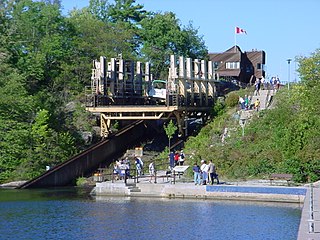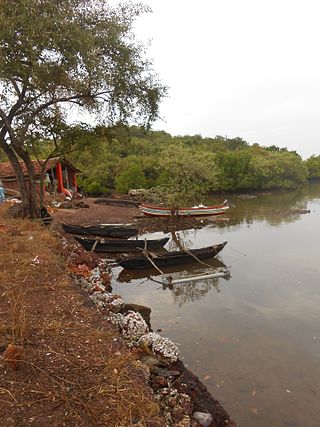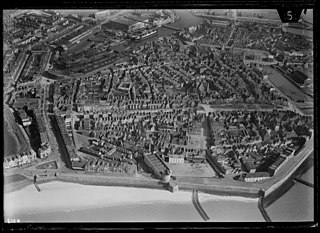
A dry dock is a narrow basin or vessel that can be flooded to allow a load to be floated in, then drained to allow that load to come to rest on a dry platform. Dry docks are used for the construction, maintenance, and repair of ships, boats, and other watercraft.

The word dock in American English refers to one or a group of human-made structures that are involved in the handling of boats or ships. In British English, the term is not used the same way as in American English, it is used to mean the area of water that is next to or around a wharf or quay. The exact meaning varies among different variants of the English language.

Meyer Werft is one of the major German shipyards, headquartered in Papenburg at the river Ems. Founded in 1795 and starting with small wooden vessels, today Meyer Werft is a builder of luxury passenger ships. 700 ships of different types have been built at the yard. Its "Dockhalle 2" is the third largest shipbuilding hall and the building with the fifth-largest usable volume in the world as of 2022.

The Oosterscheldekering, between the islands Schouwen-Duiveland and Noord-Beveland, is the largest of the Delta Works, a series of dams and storm surge barriers, designed to protect the Netherlands from flooding from the North Sea. The construction of the Delta Works was a response to the widespread damage and loss of life in the North Sea flood of 1953.

Norwegian Star is a Dawn-class cruise ship operated by Norwegian Cruise Line (NCL). Ordered by and intended for Star Cruises, it was originally named SuperStar Libra before being transferred to NCL. Norwegian Star is a Panamax cruise ship; its 294-meter-length (965 ft) and 32.2-meter-beam (105.6 ft) nears the limit for ships transiting the Panama Canal through the original set of locks.

A patent slip or marine railway is an inclined plane extending from shoreline into water, featuring a "cradle" onto which a ship is first floated, and a mechanism to haul the ship, attached to the cradle, out of the water onto a slip. The marine railway was invented by a Scot, Thomas Morton, in the early 19th century, as a cheaper alternative to dry docks for marine vessel repairs, in particular below waterline. Larger modern marine railways can handle vessels of thousands of tons.
Vuosaari shipyard was a shipyard located in the district of Vuosaari in Helsinki, Finland. Built by the Finnish state-owned company Valmet Oy in the early 1970s, the shipyard delivered 33 newbuildings and participated in building around 100 other vessels before it was closed in 1987 following the bankruptcy of Wärtsilä Marine. Later, the longest dry dock in Finland was used by various ship repair companies until the construction of the new Vuosaari harbour cut the connection to the sea in 2004. Despite various plans to re-use the old dry dock, now located inside the harbour perimeter, it remained without use until the basin was backfilled in 2015–2016.

The Port of Hull is a port at the confluence of the River Hull and the Humber Estuary in Kingston upon Hull, in the East Riding of Yorkshire, England.

A&P Group Ltd is the largest ship repair and conversion company in the UK, with three shipyards located in Hebburn, Middlesbrough and Falmouth. The company undertakes a wide variety of maintenance and repair work on commercial and military ships with projects ranging from a two-day alongside repair period through to multimillion UK pound conversion projects lasting for a year or more.

Willemsoord is a large former naval base of the Royal Netherlands Navy in Den Helder. It is now connected to the city center of Den Helder, and focuses on entertainment and tourism.

Glasson Dock, also known as Glasson, is a village in Lancashire, England, south of Lancaster at the mouth of the River Lune. In 2011, it had a population of around 600.

King George V Graving Dock, also known as No. 7 Dry Dock, is a former dry dock situated in Southampton's Western Docks. It was designed by F.E. Wentworth-Shields and constructed by John Mowlem & Company and Edmund Nuttall Sons & Company. It was formally opened by King George V and Queen Mary on 26 July 1933 although the final construction work was only complete the following year. At the time of construction it was the largest graving dock in the world, a status it retained for nearly thirty years.

The South Boston Naval Annex was a 167-acre (68 ha) United States Navy shipyard annex located in South Boston. It was the annex of the Boston Navy Yard, and was operational from the 1920 to 1974, when it was closed along with the main shipyard. The annex is also home to Dry Dock Number 3, one of the largest dry docks on the East Coast. Most of the former annex site was listed on the National Register of Historic Places in 2022.

Rameshwar Dockyard also known as Rameshwar Godi (Marathi) is a small tidal dockyard located on the west bank of Waghotan River of Sindhudurg District of Maharashtra state on the west coast of India. It is a naval dockyard built by the Maratha Admiral Kanhoji Angre about 1.5 km from Vijaydurg Fort, used mainly for repair and maintenance of ships of the Maratha Navy. The dockyard currently lies on the outskirts of a small Christian Settlement and is used only for the purpose of fishing.

Vlissingen Naval Base was a base for the Admiralty of Zeeland, and later the Dutch Navy. It has a number of major marine facilities of historic significance. It housed a shipyard for the Admiralty of Zeeland, and the national shipyard Rijkswerf Zeeland. Shipyard de Schelde would take over the grounds of the Rijkwerf, and still continues to build warships as Damen Schelde Naval Shipbuilding.

Surabaya Wooden Dock of 1,100 tons was the first floating dry dock of the Dutch East Indies.

Willemsoord Dry Dock I is a historic dry dock in Willemsoord, Den Helder, Netherlands. It was constructed from 1813 till 1822, under the direction of Jan Blanken, and was part of the former Rijkswerf Willemsoord.

Vlissingen Navy Drydock is a dry dock in Vlissingen. It is the oldest dry dock of the Netherlands, and is now a tourist attraction known as Dok van Perry.

Koopvaarders Lock in Den Helder, Netherlands connects the Noordhollandsch Kanaal to the Nieuwediep. There were 4 locks at Nieuwediep carrying this name.

The Great Balance Dock was a floating drydock in New York City. It was the largest such facility in the world when constructed in 1854, and consequently, many of the most important ships of its time were serviced there.



























